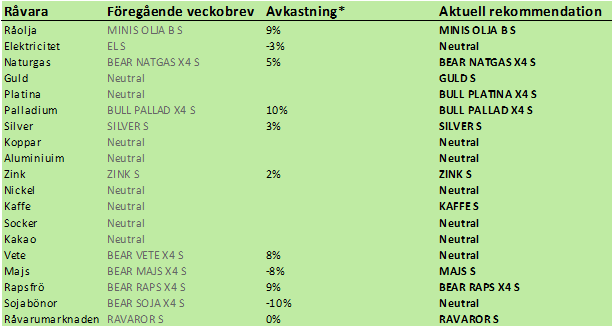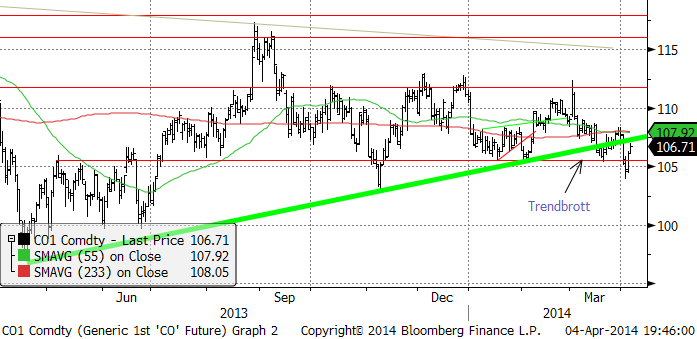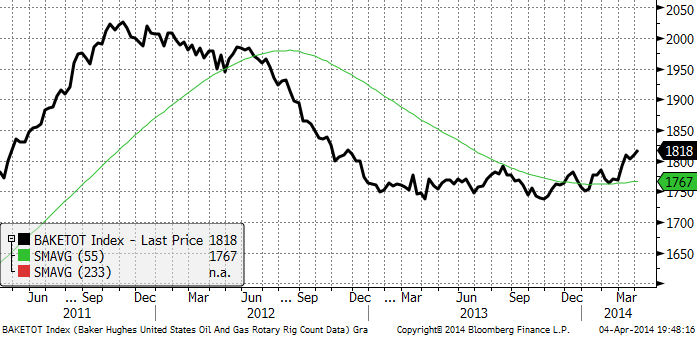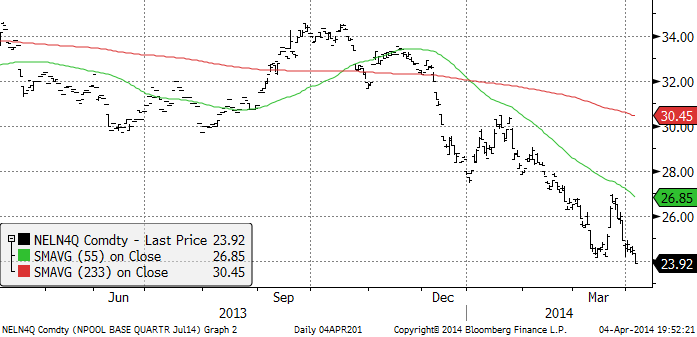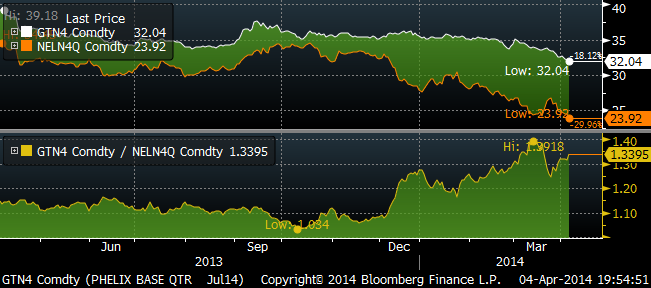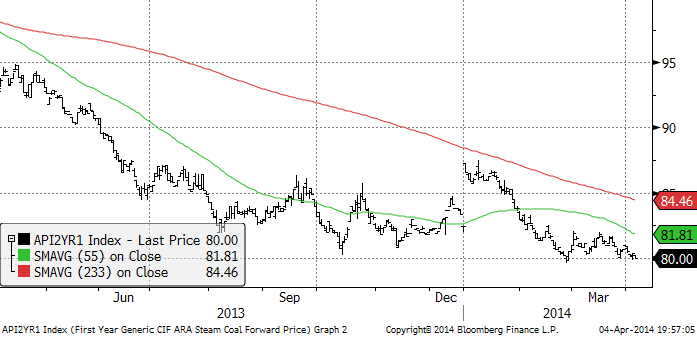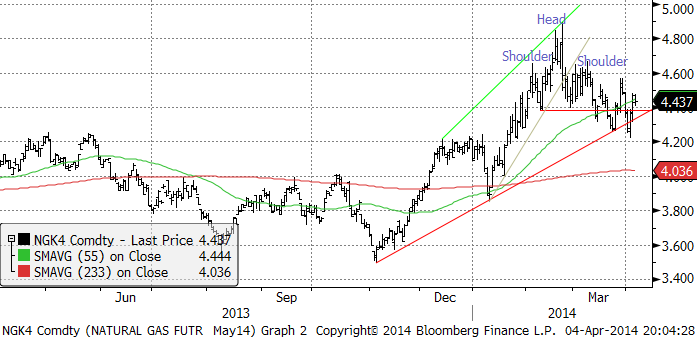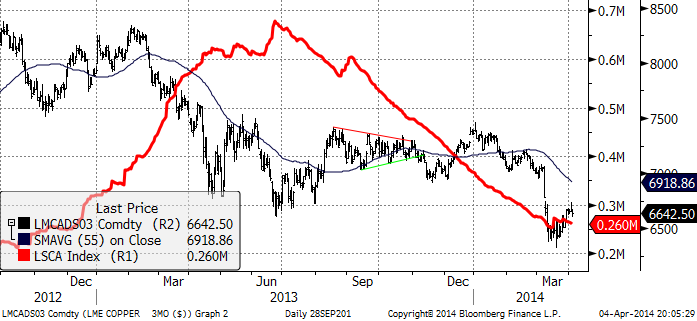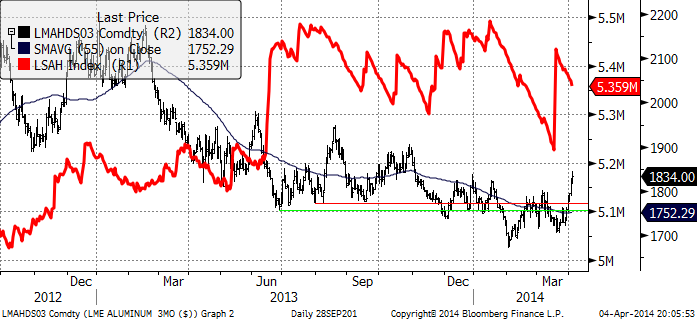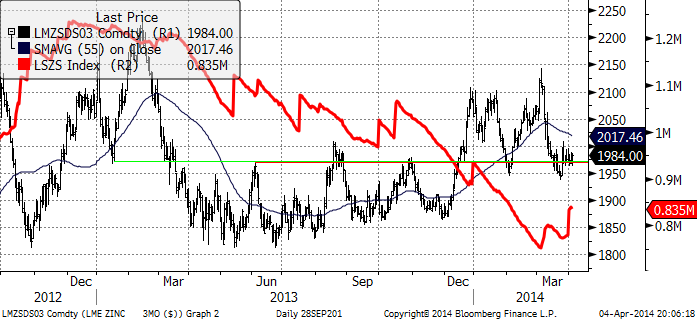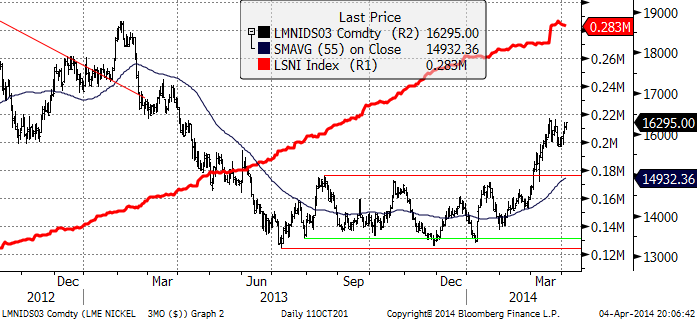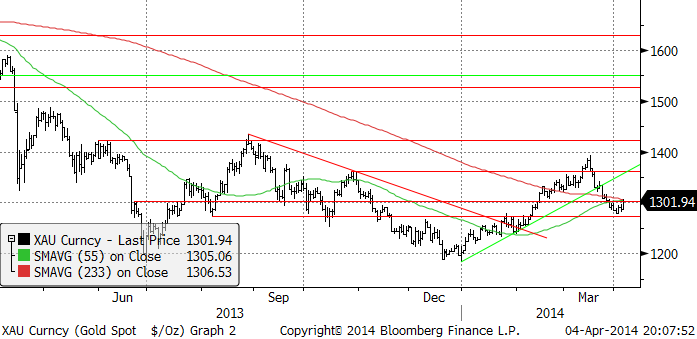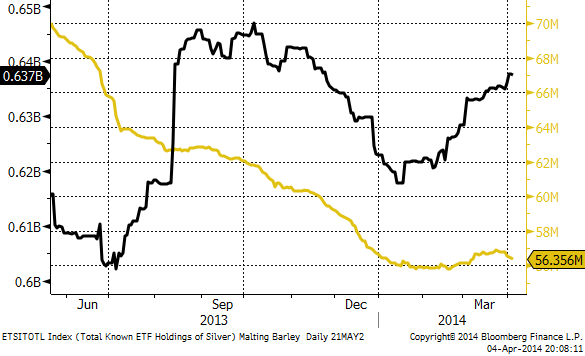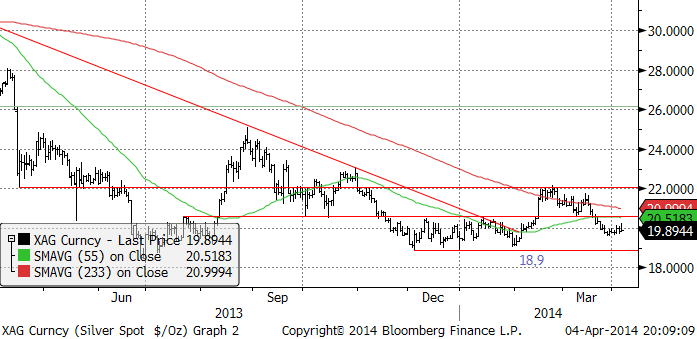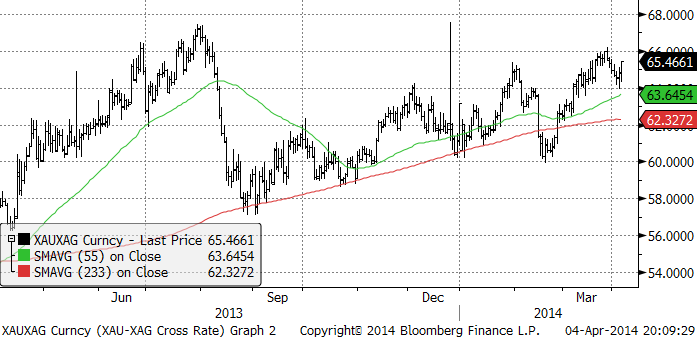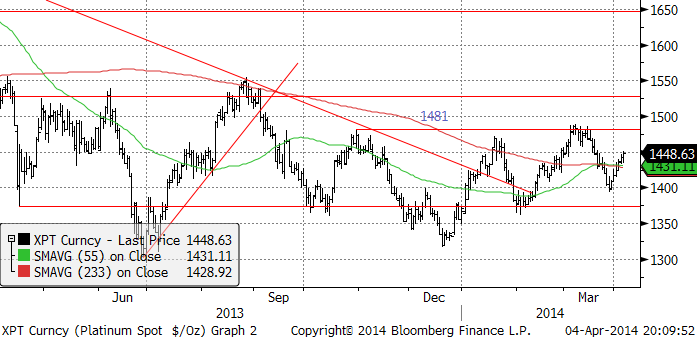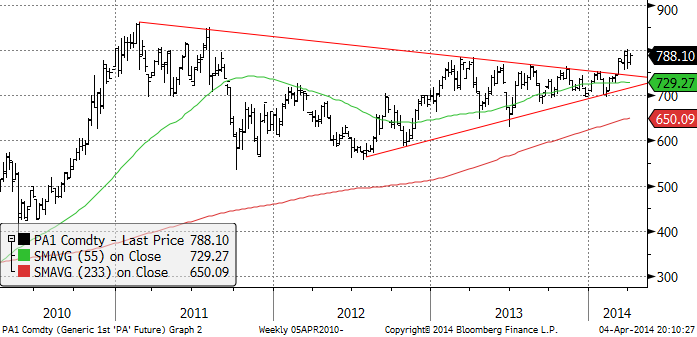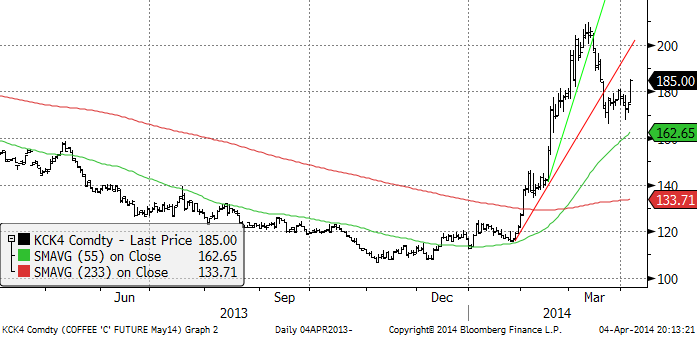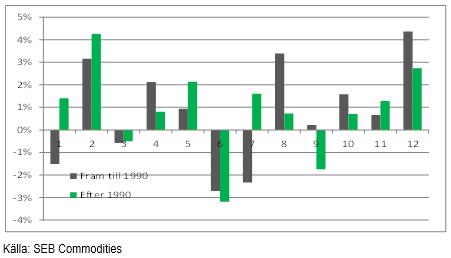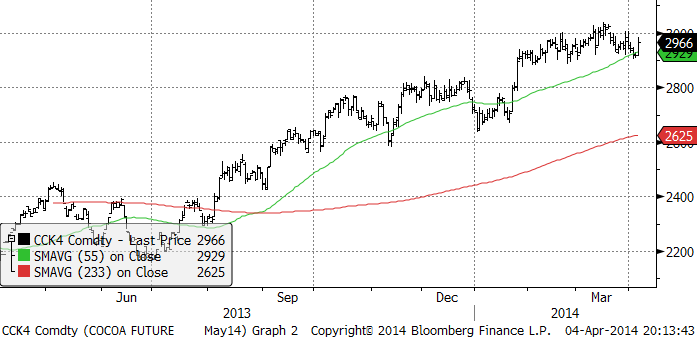Analys
SEB – Råvarukommentarer, 7 april 2014

Rekommendationer
Kort sammanfattning
Ädelmetaller, med palladium och platina som främsta val, är de vi är mest positiva till just nu. Ädelmetaller gynnas när tillväxten i världen är svagare än vad centralbankerna hoppats på, vilket innebär att (monetära) stimulanser fortsätter att vara aktuella. Platina och palladium gynnas dessutom extra av dålig lönsamhet i den sydafrikanska gruvproduktionen och arbetsmarknadskonflikterna, samt av oron för utbudet från Ryssland.
Prospective Plantings-rapporten från USDA i måndags för en vecka sedan gör att spannmål, främst majs, men även vete, bör vara väl understödda prismässgt under året 2014/15 som kommer. Jordbruksprodukterna går nu in i sin mest känsliga fas. Vädret under april, maj och juni brukar ha en avgörande inverkan på priserna under året.
SEB har noterat nya BULL och BEAR med fem gångers hävstång, ”X5”. De är för placerare som vill ta ännu mer risk än vad X4:orna erbjuder.
Råolja – Brent
Oljepriset föll ner till 104 dollar i veckan, men rekylerade sedan upp, till vad vi tror är ett nytt säljtillfälle. I Libyen har man återigen kommit till en slags samförstånd. Oljemarknaden närmar sig den säsongsmässigt svagaste tiden på året.
På lite längre sikt hopar sig molnen för oljepriset. Antalet borr-riggar i USA, statistik som Baker Hughes publicerar klockan 19 CET varje fredag, steg i fredags till den högsta nivån sedan slutet av 2012. Sedan förra veckobrevet har antalet riggar ökat från 1803 till 1818.
Råoljelagren minskade något i USA i veckans DOE-rapport. Importen sjönk däremot till en ny bottennivå.
Vi rekommenderar en kort position i olja, t ex med MINIS OLJA B S eller MINIS OLJA A S.
Elektricitet
Vändningen uppåt kom återigen på skam och en ny teknisk säljsignal registrerades under fredagens handel. Väderleksprognosen visar fortsatt nederbörd över det normala över Skanderna de kommande två veckorna. Temperaturen är mild. Hydrologisk balans är något över det normala, men det beror på att vattnet i rask takt omvandlas till kraft. Under årets första 13 veckor är nettoexporten från Sverige 6.8 TWh. Det är den största exporten åtminstone sedan elmarknaden avreglerades år 1996. Exporten är dubbelt så stor som motsvarande period förra året.
Phelix Baseload för det tredje kvartalet, Tysklands motsvarande kontrakt som tredje kvartalet på Nasdaq Commodities, ligger nu 34% över det nordiska. Det är alltså den nordiska marknaden som är ovanligt billig.
Priset på utsläppsrätter har kollapsat efter den politiskt drivna prisuppgången i början av året. I januari steg priset från 4.75 till 7.41 euro per ton som högst i början på mars. Därefter, kanske på grund av Rysslands angrepp på Ukraina och det uppvaknande detta är för energipolitiken i EU, föll priset i mars till under 4 euro som lägst. Just nu hänger priset på 4.74 euro per ton, men tekniskt ser det ut som om de som sålde ner rätterna till under 4 euro har mer rätt.
Priset på kol har stabiliserat sig på 80 dollar, som är en teknisk stödnivå. Lägre toppar med 80 som stöd varnar dock om att sentimentet är negativt.
På kort sikt ser elpriset ut att kunna gå ännu lägre, därför går vi över till neutral rekommendation igen. Vi vill inte rekommendera en kort position, därför att priset är så lågt i ett historiskt perspektiv.
Naturgas
Den tekniska ”huvud-skuldra” formation som vi skrev om i det förra veckobrevet har inte utvecklat sig som det skulle. Istället har marknaden gått in i en konsolideringsfas på en nivå något under toppnoteringen. Än är det dock lite för tidigt att ändra uppfattning. Det ser fortfarande ut som om trenden är nedåtriktad.
Koppar
Kopparpriset fortsatte att rekylera uppåt för den tredje veckan i rad, men rekylen är nog just en sådan. De flesta tvivlar på den underliggande styrkan i marknaden. I fredags handlade marknaden svag inför stängning, vilket faktiskt medförde att börsen stängde på en lägre nivå än veckan innan. Skulle det bli en ytterligare uppgång, kommer aktörer att utnyttja tillfället för att sälja.
Inte ens veckans jordbävning i Chile kunde påverka priset mer än marginellt. Även om inga skador tycks ha vållats kopparproduktionen, skulle en sådan händelse haft en större påverkan i en mer positiv marknad. Chile står för drygt 20% av global kopparproduktion. Den lama reaktionen måste tolkas som ett svaghetstecken. Andra produktionsstörningar som kommer att påverka marknaden de kommande månaderna (runt 80 kt enligt Metal Bulletin), struntar marknaden i. Det är dock en fråga om hur lågt kineserna kan låta priset gå. På föregående nerställ av den här magnituden har kinesiska konsumenter tagit tillfället i akt och köpt på sig reserver, eftersom koppar är en så strategisk resurs för landet. Kanske spelar kreditproblemen i Kina in den här gången, men eventuella köp från kinesiskt håll är en faktor att beakta. Med det sagt, ser den tekniska bilden sådan ut att ett nytt test av bottennoteringen i mars kan vara nära förestående.
Vi rekommenderar kortsiktigt sälj på koppar.
Aluminium
LME:s förslag för att minska väntetiden för att plocka ut metall från LME:s lagerhus klandrades i domstol av lagerhusen. Den 27 mars föll domen. Sedan dess har terminspriset på aluminium gått upp med 100 dollar på LME. Orsaken är den kortsiktiga effekten på utbudet (från lagerhusen), snarare än en förändring i den långsiktiga fundamentala balansen. Nu är det fortfarande oklart vad som kommer att hända och marknaden väntar på besked från LME. Ingenting har hörts än. De flesta observatörer anser dock att det är osannolikt att lagerhusen kommer att försöka attrahera ännu mer metall. Så när allt kommer omkring har ingenting förändrats. Intressant nog har den fysiska premien inte förändrats. Det finns bara en liten höjning för fysisk metall i Mellanvästern.
Förra veckan besked om produktionsneddragningar i Brasilien (150 kt / år) föll i skuggan av fokuset på lagerproblematiken, men återspeglar den successiva minskning av produktionen som påverkar marknaden på längre sikt. Vi tror dock att det är lite för tidigt för en uppgång av större betydelse i priset.
Tekniskt ser utvecklingen mer positiv ut, men priset balanserar på ett tekniskt stöd i den långsiktiga fallande trenden. Somliga analytiker pekar på att 200-dagars glidande medelvärde har brutits och fäster stor vikt vid det. Vi håller med om att en trendförändring kan vara förestående, men tror det är mer sannolikt med en kortsiktig rekyl mot 1,800 dollar.
Vi fortsätter med neutral rekommendation på aluminium.
Zink
Zinkmarknaden har handlats omotiverat svagt. Zink har i viss utsträckning infekterats av utvecklingen i kopparmarknaden. Det kan bero på att båda metallerna hålls som pant i finansieringsaffärer i Kina, även om det för zink sker i mycket mindre utsträckning. I veckan som gick påminde ILZSG om den förbättrande fundamentala balansen. ILZSG förutspår en produktionsökning med 4.4% till 13.41 mt under 2014. Användningen ökar med 4.5% till 13.58 mt. Detta innebär att det blir ett underskott på 117 kt. Detta är i linje med den trend vi har sett den senaste tiden och som också återspeglar sig i den kontinuerliga minskningen av LME-lagren. Den senaste tiden har dock material också kommit till ytan, förmodligen material som lämnar finansieringsaffärer när terminskurvans contango minskat. Det kommer att bli intressant att se lagerrörelserna runt den 3:e onsdagen i april – om korta terminspositioner kommer att levereras på, eller rullas framåt. Säsongsmässigt ökande aktivitet i byggsektorn borde gynna zinkpriset de kommande månaderna, men om kopparmarknaden fortsätter att utvecklas svagt, ska man vara varse att det finns en smitta, omotiverat eller inte, från den marknaden till zink.
Vi rekommenderar köp av ZINK S eller BULL ZINK X4 S.
Nickel
Rekylen i priset tillbaka till 15,900 dollar per ton var tydligen tillräckligt. Det generella positiva sentimentet i början av veckan lyfte priset till över 16,000 dollar. Det har inte funnits några nickel-specifika nyheter. De två positiva faktorer som ger marknaden stöd, för det första Indonesiens exportförbud och risken för sanktioner mot Ryssland, fortsätter att påverka marknaden. Vi tror dock att den sistnämnda har försumbar risk att påverka marknaden. Däremot har kostnaderna för att producera nickel i Ryssland stigit, eftersom kapitalkostnaden gått upp för investeringar i Ryssland. Detta är dock inte något som syns i aktiekursen för Norilsk Nickel, som utvecklats positivt. För det fall EU och USA inför någon slags importförbud av nickel från Ryssland kan Norilsk skeppa till Kina istället. I fredags stängde marknaden på en ny årshögsta på 16,590, men tappade momentum inför stängningen. Vi tycker att den här marknaden rusar allt för långt framför fundamenta, även om det finns utsikter för en väsentligt ”tightare” balans senare i år.
Guld
Antalet nyanställda i USA steg mindre än väntat och det fick guldpriset att stiga i fredags, efter en vecka med dalande kurs. Antalet nyanställda i USA ökkade med 192,000 jobb, vilket var mindre än de 200,000 som väntades. Arbetsmarknaden fortsätter alltså att utvecklas mindre väl än vad FED väntade sig när de inledde nedtrappningen (”tapering”) av QE3 strax före Jul. Det har fått den nya centralbankschefen Janet Yellen att säga att den amerikanska ekonomin kommer att behöva monetär stimulans ”någon” tid. Janet Yellen gjorde sitt mest hök-aktiga uttalande när on svors in. Det har sagts om henne att hon påminner om en svärmor, en sådan person som aldrig ändrar sig. Hon har alltid varit en ”duva” i monetära sammanhang och det får hon nu allt mer chansen att vara. Detta innebär också att räntehöjningarna som kommer efter att QE3 är avvecklat, har skjutits upp ytterligare.
Priset på guld har rekylerat ner sedan mitten av mars, efter att spänningarna mellan EU / USA och Ryssland nådde sin varmaste nivå sedan det Kalla Kriget tog slut för 20 år sedan. Det är efterfrågan på fysiskt guld som gynnas av den sortens faktor. Importen till Indien fördubblades i mars i förhållande till februari. Att USA, nu allt mer EU (som pratiskt taget har deflation) och nu även Kina annonserat mer statlig stimulans, gynnar guldpriset.
Tekniskt ser vi att guldpriset vände uppåt precis på en känd stödnivå och nu ligger precis under ett tekniskt motstånd. Om det bryts på uppsidan i veckan, kan uppgången fortsätta.
Guld pekas ut som den sämsta metallen att äga i år i en enkätundersökning som Barclays genomförde på sitt seminarium för råvaruinvesterare den 27 mars. Ett så solitt negativt sentiment kan också tolkas som ett köptillfälle enligt ”contrary opionion”-synsättet. Det gäller bara att vänta på den riktiga ”triggern” för en uppgång.
ETF-investerare har återigen sålt ETF:er på guld. Däremot har de fortsatt att köpa silver – den svarta kurvan nedan, vilket vi kan förstå.
Vi har tidigare skrivit att vi skulle vilja köpa guld om det kom en rekyl och det har det gjort. Så vi går alltså över till köprekommendation på guld och rekommenderar köp av GULD S.
Silver
Silverpriset har fallit ner till den gamla konsolideringsnivån mellan 18.90 och 20 dollar per fin-uns. Vi tycker att silver ser mer köpvärt ut än guld, främst för att guld handlas på ett högt pris i silvertermer.
Nedan ser vi ett diagram över priset på guld uttryckt i silver. Det går alltså över 65 finuns silver på varje fin-uns av guld. Som vi ser är det en hög nivå, dvs silver är billigt i förhållande till guld.
Vi anser att silver är mer köpvärt än guld och skulle vilja köpa på de här nivåerna, i synnerhet efter den rekyl som inträffat de senaste veckorna.
Platina & Palladium
70.000 gruvarbetare strejkar i Sydafrika sedan den 23 januari. Gruvbolagen går med förlust och kan rimligtvis inte betala högre löner. I veckan fick vi rapporter om att gruvbolagens reservlager av metall håller på att ta slut. Man överväger att köpa platina på marknaden för att kunna fullfölja sina leveranskontrakt.
Mer eller mindre officiella källor i Sydafrika uppmanar till skapandet av den kartell som föreslogs av Ryssland för något år sedan, för att minska utbudet av metall. Ryssland och Sydafrika står för 80% av global produktion av PGM-metallerna och Sydafrika står för det mesta av det.
Priset på palladium, som bröt den stora triangelformationen, ser ut att snart bryta 800 dollar per fin-uns. Vi har säkert en stor ”bull market” framför oss i palladium också.
Vi rekommenderar köp av PLATINA S och PALLADIUM S, eller BULL PLATINA X4 S eller BULL PALLAD X4 S.
Sedan förra veckan finns även BULL och BEAR ”X5”, dvs fem gångers hävstång på platina och palladium.
Kaffe
Kaffepriset tog ett rejält kliv upp under fredagens handel. Bakom tycks det första estimatet på den brasilianska skörden efter torkan ligga. Den brasilianska odlarföreningen CNC skrev i ett email i fredags att skörden ser ut att hamn i intervallet 40.1 – 43.3 miljoner säckar. Brasiliens skörd förra året var 53.7 miljoner säckar och väntades bli 53.1 miljoner i år enligt USDA eller 46.5 – 50.2 enligt CONAB i januari (innan torkan slog till). CNC:s uppgifter återspeglar verkligen en skördekatastrof och motiverar ett högre pris.
Den historiska månadsavkastningen indikerar att mars är en svag månad och april en uppgångsmånad, som vi ser av tabellen nedan, som visar genomsnittlig månadsavkastning för respektive månad från tidigt 70-tal fram till 1990 och dito åren efter 1990.
Vi går över till köprekommendation (KAFFE S) från neutral.
Kakao
Priset på kakao i New York stängde upp ganska kraftigt i fredags. Den allmänna bilden är dock att prisuppgången tappat momentum. De två senaste månaderna har priset legat stabilt under den tekniska motståndsnivån 3000 dollar.
Leveranserna av kakaobönor till hamnarna i Elfenbenskusten, den största producenten i världen, steg med 8.2% under perioden 1 oktober – 30 mars, jämfört med förra året. Leveranserna är de största sedan åtminstone 2004/05, det första året som man började föra statistik på leveranserna till hamnarna. Dessa data har sammanställts av Commodities Risk Analysis och är baserat på antalet lastbilar som setts anlända till hamnarna. Det är knappast en nyhet som kan driva priset på kakao högre.
Vi rekommenderar en neutral position vid dagens situation.
För analyser på fler jordbruksråvaror se SEBs analysbrev från tidigare idag.
[box]SEB Veckobrev Veckans råvarukommentar är producerat av SEB Merchant Banking och publiceras i samarbete och med tillstånd på Råvarumarknaden.se[/box]
Disclaimer
The information in this document has been compiled by SEB Merchant Banking, a division within Skandinaviska Enskilda Banken AB (publ) (“SEB”).
Opinions contained in this report represent the bank’s present opinion only and are subject to change without notice. All information contained in this report has been compiled in good faith from sources believed to be reliable. However, no representation or warranty, expressed or implied, is made with respect to the completeness or accuracy of its contents and the information is not to be relied upon as authoritative. Anyone considering taking actions based upon the content of this document is urged to base his or her investment decisions upon such investigations as he or she deems necessary. This document is being provided as information only, and no specific actions are being solicited as a result of it; to the extent permitted by law, no liability whatsoever is accepted for any direct or consequential loss arising from use of this document or its contents.
About SEB
SEB is a public company incorporated in Stockholm, Sweden, with limited liability. It is a participant at major Nordic and other European Regulated Markets and Multilateral Trading Facilities (as well as some non-European equivalent markets) for trading in financial instruments, such as markets operated by NASDAQ OMX, NYSE Euronext, London Stock Exchange, Deutsche Börse, Swiss Exchanges, Turquoise and Chi-X. SEB is authorized and regulated by Finansinspektionen in Sweden; it is authorized and subject to limited regulation by the Financial Services Authority for the conduct of designated investment business in the UK, and is subject to the provisions of relevant regulators in all other jurisdictions where SEB conducts operations. SEB Merchant Banking. All rights reserved.
Analys
Tightening fundamentals – bullish inventories from DOE

The latest weekly report from the US DOE showed a substantial drawdown across key petroleum categories, adding more upside potential to the fundamental picture.

Commercial crude inventories (excl. SPR) fell by 5.8 million barrels, bringing total inventories down to 415.1 million barrels. Now sitting 11% below the five-year seasonal norm and placed in the lowest 2015-2022 range (see picture below).
Product inventories also tightened further last week. Gasoline inventories declined by 2.1 million barrels, with reductions seen in both finished gasoline and blending components. Current gasoline levels are about 3% below the five-year average for this time of year.
Among products, the most notable move came in diesel, where inventories dropped by almost 4.1 million barrels, deepening the deficit to around 20% below seasonal norms – continuing to underscore the persistent supply tightness in diesel markets.
The only area of inventory growth was in propane/propylene, which posted a significant 5.1-million-barrel build and now stands 9% above the five-year average.
Total commercial petroleum inventories (crude plus refined products) declined by 4.2 million barrels on the week, reinforcing the overall tightening of US crude and products.


Analys
Bombs to ”ceasefire” in hours – Brent below $70

A classic case of “buy the rumor, sell the news” played out in oil markets, as Brent crude has dropped sharply – down nearly USD 10 per barrel since yesterday evening – following Iran’s retaliatory strike on a U.S. air base in Qatar. The immediate reaction was: “That was it?” The strike followed a carefully calibrated, non-escalatory playbook, avoiding direct threats to energy infrastructure or disruption of shipping through the Strait of Hormuz – thus calming worst-case fears.

After Monday morning’s sharp spike to USD 81.4 per barrel, triggered by the U.S. bombing of Iranian nuclear facilities, oil prices drifted sideways in anticipation of a potential Iranian response. That response came with advance warning and caused limited physical damage. Early this morning, both the U.S. President and Iranian state media announced a ceasefire, effectively placing a lid on the immediate conflict risk – at least for now.
As a result, Brent crude has now fallen by a total of USD 12 from Monday’s peak, currently trading around USD 69 per barrel.
Looking beyond geopolitics, the market will now shift its focus to the upcoming OPEC+ meeting in early July. Saudi Arabia’s decision to increase output earlier this year – despite falling prices – has drawn renewed attention considering recent developments. Some suggest this was a response to U.S. pressure to offset potential Iranian supply losses.
However, consensus is that the move was driven more by internal OPEC+ dynamics. After years of curbing production to support prices, Riyadh had grown frustrated with quota-busting by several members (notably Kazakhstan). With Saudi Arabia cutting up to 2 million barrels per day – roughly 2% of global supply – returns were diminishing, and the risk of losing market share was rising. The production increase is widely seen as an effort to reassert leadership and restore discipline within the group.
That said, the FT recently stated that, the Saudis remain wary of past missteps. In 2018, Riyadh ramped up output at Trump’s request ahead of Iran sanctions, only to see prices collapse when the U.S. granted broad waivers – triggering oversupply. Officials have reportedly made it clear they don’t intend to repeat that mistake.
The recent visit by President Trump to Saudi Arabia, which included agreements on AI, defense, and nuclear cooperation, suggests a broader strategic alignment. This has fueled speculation about a quiet “pump-for-politics” deal behind recent production moves.
Looking ahead, oil prices have now retraced the entire rally sparked by the June 13 Israel–Iran escalation. This retreat provides more political and policy space for both the U.S. and Saudi Arabia. Specifically, it makes it easier for Riyadh to scale back its three recent production hikes of 411,000 barrels each, potentially returning to more moderate increases of 137,000 barrels for August and September.
In short: with no major loss of Iranian supply to the market, OPEC+ – led by Saudi Arabia – no longer needs to compensate for a disruption that hasn’t materialized, especially not to please the U.S. at the cost of its own market strategy. As the Saudis themselves have signaled, they are unlikely to repeat previous mistakes.
Conclusion: With Brent now in the high USD 60s, buying oil looks fundamentally justified. The geopolitical premium has deflated, but tensions between Israel and Iran remain unresolved – and the risk of missteps and renewed escalation still lingers. In fact, even this morning, reports have emerged of renewed missile fire despite the declared “truce.” The path forward may be calmer – but it is far from stable.
Analys
A muted price reaction. Market looks relaxed, but it is still on edge waiting for what Iran will do

Brent crossed the 80-line this morning but quickly fell back assigning limited probability for Iran choosing to close the Strait of Hormuz. Brent traded in a range of USD 70.56 – 79.04/b last week as the market fluctuated between ”Iran wants a deal” and ”US is about to attack Iran”. At the end of the week though, Donald Trump managed to convince markets (and probably also Iran) that he would make a decision within two weeks. I.e. no imminent attack. Previously when when he has talked about ”making a decision within two weeks” he has often ended up doing nothing in the end. The oil market relaxed as a result and the week ended at USD 77.01/b which is just USD 6/b above the year to date average of USD 71/b.

Brent jumped to USD 81.4/b this morning, the highest since mid-January, but then quickly fell back to a current price of USD 78.2/b which is only up 1.5% versus the close on Friday. As such the market is pricing a fairly low probability that Iran will actually close the Strait of Hormuz. Probably because it will hurt Iranian oil exports as well as the global oil market.
It was however all smoke and mirrors. Deception. The US attacked Iran on Saturday. The attack involved 125 warplanes, submarines and surface warships and 14 bunker buster bombs were dropped on Iranian nuclear sites including Fordow, Natanz and Isfahan. In response the Iranian Parliament voted in support of closing the Strait of Hormuz where some 17 mb of crude and products is transported to the global market every day plus significant volumes of LNG. This is however merely an advise to the Supreme leader Ayatollah Ali Khamenei and the Supreme National Security Council which sits with the final and actual decision.
No supply of oil is lost yet. It is about the risk of Iran closing the Strait of Hormuz or not. So far not a single drop of oil supply has been lost to the global market. The price at the moment is all about the assessed risk of loss of supply. Will Iran choose to choke of the Strait of Hormuz or not? That is the big question. It would be painful for US consumers, for Donald Trump’s voter base, for the global economy but also for Iran and its population which relies on oil exports and income from selling oil out of that Strait as well. As such it is not a no-brainer choice for Iran to close the Strait for oil exports. And looking at the il price this morning it is clear that the oil market doesn’t assign a very high probability of it happening. It is however probably well within the capability of Iran to close the Strait off with rockets, mines, air-drones and possibly sea-drones. Just look at how Ukraine has been able to control and damage the Russian Black Sea fleet.
What to do about the highly enriched uranium which has gone missing? While the US and Israel can celebrate their destruction of Iranian nuclear facilities they are also scratching their heads over what to do with the lost Iranian nuclear material. Iran had 408 kg of highly enriched uranium (IAEA). Almost weapons grade. Enough for some 10 nuclear warheads. It seems to have been transported out of Fordow before the attack this weekend.
The market is still on edge. USD 80-something/b seems sensible while we wait. The oil market reaction to this weekend’s events is very muted so far. The market is still on edge awaiting what Iran will do. Because Iran will do something. But what and when? An oil price of 80-something seems like a sensible level until something do happen.
-

 Nyheter4 veckor sedan
Nyheter4 veckor sedanStor uppsida i Lappland Guldprospekterings aktie enligt analys
-

 Nyheter4 veckor sedan
Nyheter4 veckor sedanSilverpriset släpar efter guldets utveckling, har mer uppsida
-

 Nyheter3 veckor sedan
Nyheter3 veckor sedanUppgången i oljepriset planade ut under helgen
-

 Nyheter3 veckor sedan
Nyheter3 veckor sedanLåga elpriser i sommar – men mellersta Sverige får en ökning
-

 Nyheter2 veckor sedan
Nyheter2 veckor sedanMahvie Minerals växlar spår – satsar fullt ut på guld
-

 Analys3 veckor sedan
Analys3 veckor sedanVery relaxed at USD 75/b. Risk barometer will likely fluctuate to higher levels with Brent into the 80ies or higher coming 2-3 weeks
-

 Nyheter1 vecka sedan
Nyheter1 vecka sedanOljan, guldet och marknadens oroande tystnad
-

 Nyheter1 vecka sedan
Nyheter1 vecka sedanJonas Lindvall är tillbaka med ett nytt oljebolag, Perthro, som ska börsnoteras


